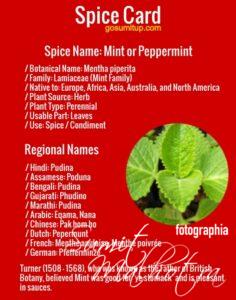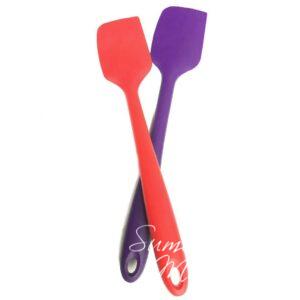All About Mint | Know Your Spice Pudina or Peppermint (Mentha piperita)
Mint (Mentha piperita) or Peppermint are aromatic perennial herbs are distributed mostly in the Northern hemisphere.
In India, it is largely confined to North India in the States of Uttar Pradesh, Punjab and Haryana.
The most common mints for growing are peppermint (Mentha piperita), spearmint (Mentha spicata), Scotch spearmint (Mentha gracilis), and cornmint (Mentha arvensis).
More recently apple mint (Mentha suaveolens) has gained attraction as well.
Out of these Peppermint (Mentha piperita) is quite commonly used for culinary purposes and this article primarily relates to it.
The herb leaves should be used fresh in almost all cases for cooking. However, dried leaves maybe used for beverages and desserts.
What are the other names of Mint (Mentha piperita)?
| Indian Languages | Other Languages | |
| Hindi: Pudina Assamese: Poduna Bengali: Pudina Gujarati: Phudino Marathi: Pudina Malayalam: Puthina Sanskrit: Putiha, Podinaka Tamil: Pudina Telugu: Pudina | Latin (Botanical): Mentha piperita Arabic: Eqama, Nana Chinese: Pak hom ho Dutch: Pepermunt French: Menthe anglaise, Menthe poivrée German: Pfefferminze Italian: Menta pepe Spanish: Hierbabuena, Menta Swedish: Pepparmynta |
What exactly is mint?
Mint (also known as mentha) is a genus of plants in the family Lamiaceae (Mint family). 13 to 24 species of the plant exist, but the exact distinction between species is unclear.
These are aromatic perennial herbs that grow best in wet environments and moist soils.
They have erect, squarish branched stems. The leaves are arranged in opposite pairs, from oblong to lanceolate, often downy, and with a serrated margin.
All mints thrive near pools of water, lakes, rivers, and cool moist spots in partial shade.
In general, pudina herb tolerates a wide range of conditions, and can also be grown in full sun. Peppermint grows all year round.
Mentha has a sub cosmopolitan distribution across Europe, Africa, Asia, Australia, and North America.
Pudina can grow 10–120 cm (4-48 inches) tall and can spread over an indeterminate area.
What is the nutritional value of Mints?
3.2 grams (g) of fresh peppermint provides:
2.24 calories, 0.12 g of protein, 0.48 g of carbohydrates, 0.03 g of fat, 0.26 g of fiber.
Mint also contains trace amounts of potassium, magnesium, calcium, phosphorus, vitamin A & C and iron.
What is the chemical composition of Mint?
Peppermint has a high menthol content. The oil also contains menthone and carboxyl esters, particularly menthyl acetate.
Dried peppermint typically has 0.3–0.4% of volatile oil containing menthol (7–48%), menthone (20–46%), menthyl acetate (3–10%), menthofuran (1–17%) and 1,8-cineol (3–6%).
Peppermint oil also contains small amounts of many additional compounds including limonene, pulegone, caryophyllene and pinene.
Peppermint contains terpenoids and flavonoids such as eriocitrin, hesperidin, and kaempferol 7-O-rutinoside.
What is the history of Mint?
The herb history is colored by stories from ancient mythology. Proserpine, Pluto’s wife, was said to have transformed a hated rival into the mint plant.
Both the Latin, Metha, and the Greek, Minthe, have come to be associated with metamorphosed beauty.
In Ancient Athens, where it was common to scent different parts of the body with different herbs, peppermint was the scent most commonly used on the arms.
Peppermint history has it being introduced to England by the Romans and is mentioned by John Gardiner before 1440 as ‘myntys’.
In the 14th Century there were early versions of toothpaste. It was used during that time for whitening teeth.
Turner (1508 – 1568), who was known as the Father of British Botany, believed it was good for ‘ye stomack’ and is pleasant in sauces.
Culpepper (1616 – 1654), a physician-astrologer suggested that it should never be given to a wounded man because it will prevent his wound from healing.
Culpepper used peppermint to treat almost 40 different ailments.
In the 17th Century, John Gerarde described menthe as having a “smelle rejoyceth the heart of man.”
Peppermint history identifies the Pilgrims as the people most likely responsible for bringing the herb to the New World.
What are the uses of Mint?
- The peppermints are especially good culinary mints, ideal for chopping into salads, sprinkling over fruits or combining with basil or cilantro to make mint pesto.
- Peppermint leaves or frozen cubes are added to mojitos, iced tea, or fresh lemonade and even tea. Making a watermelon lemonade, add it to it as well.
- Mints are are traditional tea herbs. Simply steep your fresh mint leaves in boiling water for about five minutes and serve. It’s a great digestive aid after dinner.
- Peppermint teas and extracts have been used for centuries as a mouthwash for oral infections.
- Your home will smell fresher by adding a few drops of peppermint essential oil in your oil diffuser. This is a great mosquito repellant too.
- Keep your pets flea-free by stuffing a small pillow with fresh spearmint and thyme and placing near your pet’s bed.
- Combine fresh cucumbers and peppermint leaves with Epsom salt to create a lightly scented and refreshing bath soak.
What does Mint taste like?
Peppermint tastes sweet and produces a lingering cool effect on the tongue. It has a stronger flavour with more menthol taste.
Here you go with the recipe of Mint & Coriander Chutney
What can I use Mint for?
- Mix plain unsweetened Greek yogurt with strawberries (or mixed berries) and sprinkle with chopped fresh peppermint leaves.
- Make Peppermint Teas – Use 5-10 big leaves or more depending on how strong you want. Simply muddle the leaves for a few seconds & steep in hot water for 10 minutes.
- Use them for watermelon pops or a watermelon salad with feta cheese & basil.
- Add peppermint leaves to a basil pesto or make your own mint & coriander chutney.
- Add fresh peppermint to plain or sparkling water. You can also freeze whole mint leaves into ice cubes for a pretty (and tasty) addition to your water.
- Use it in your cocktails. Peppermint also adds an amazing freshness to any pressed juice.
- Make your own peppermint-infused cocktail vodka.
- Add it to sugar & make your own minty sugar. You can use it to sprinkle on cookies, muffins or sweet breads.
- Add a few fresh peppermint leaves to your soup while it cooks to make it make your soup flavourful and healthy.
- Add it to cucumber and pomegranate salad or other fruit salads only to enhance the flavour.
- Blend the curd with fresh peppermint leaves, black salt, sugar and cumin for a refreshing lassi.
How long does Mint last?
Properly stored, fresh peppermint leaves will usually keep well for about 7 to 10 days in the refrigerator.
How do I store Mint?
- Wrap the peppermint leaves gently in a damp paper towel.
- Place the peppermint leaves in a plastic bag, not sealing all the way so that air can circulate. Do not wrap tightly; trapped moisture will cause the herbs to mold.
- Trim the ends and place in a glass filled with about 1” of water.
Is there a substitute for Mint?
- Substitute 1 tablespoon chopped with 1 teaspoon dried peppermint. The proportion of fresh to dry herbs is 1/4th.
- 1 teaspoon of peppermint from a herbal tea bag.
- 1 drop peppermint oil and taste before adding more. Use it only for beverages or baked goods or liquid preparations, don’t use for salad.
- For an alternate flavor, try substituting 1 tablespoon chopped parsley or chopped fresh basil.
Where do I buy Mint from?
You should look for dried peppermint in the spice section of your supermarket. Store them tightly sealed in a dark location.
Fresh herb is commonly available in the fruit & vegetable sections of most supermarkets and online too.
If you have a farmer’s spirit, simply grow some Mentha piperita herb in your kitchen garden or a pot.
What are the health benefits of Mint?
The following are health benefits of Mint Leaves, Peppermint or Peppermint
- Health Benefits of Peppermint for Digestion – Mint may also be effective at relieving other digestive problems such as upset stomach and indigestion.
- Health Benefits of Mint for Imporving Brain Function – In addition to ingesting mint, there are claims that inhaling the aroma of essential oils from the plant could provide health benefits, including improved brain function.
- Health Benefits of Peppermint against Breast Feeding Pain – Studies have shown that applying mint to the skin can help relieve pain associated with breastfeeding.
- Health Benefits of Peppermint against Fever & Flu – Many over-the-counter cold and flu treatments contain menthol, a primary compound in peppermint oil.
- Health Benefits of Mint against Bad Breath – Mint-flavored chewing gum and breath mints are some of the first things people reach for when trying to prevent or get rid of bad breath.
- Health Benefits of Peppermint for Nutrition – Mint is a particularly good source of vitamin A, a fat-soluble vitamin that is critical for eye health and night visio.
- Health Benefits of Pudina for Respiration – Mint leaves are highly recommended for asthma patients, as it acts as a good relaxant and relieves chest congestion.
- Health Benefits of Peppermint for Boosting Your Immunity – Mint is full of vitamins and antioxidants to improve your immunity. These plant-based vitamins help to protect your cells from damage.
- Health Benefits of Pudina against Obesity – Mint leaves play an essential role in losing weight in a healthy way. Mint leaves promote digestion and boost metabolism to help in losing weight.
- Health Benefits of Pudina against Stress – Mint is an essential part of aromatherapy. It’s strong and refreshing smell could help beat stress and rejuvenate the mind.
- Health Benefits of Pudina for Skin care – Antibacterial, antifungal, and anti-inflammatory properties of mint leaves are effective in treating acne and lowers the inflammation and redness associated with acne outbursts.
Mint leaves are generally safe for consumption, however people with gastroesophageal reflux disease should minimize the consumption as it may cause stomach irritation.
Tools & Equipment Used For This Recipe
FInally! To Sum It Up
Mint (Mentha piperita) or Peppermint are aromatic perennial herbs are distributed mostly in the Northern hemisphere.
In India, it is largely confined to North India in the States of Uttar Pradesh, Punjab and Haryana.
The most common mints for growing are peppermint (Mentha piperita), spearmint (Mentha spicata), Scotch spearmint (Mentha gracilis), and cornmint (Mentha arvensis).
More recently apple mint (Mentha suaveolens) has gained attraction as well.
Out of these Peppermint (Mentha piperita) is quite commonly used for culinary purposes and this article primarily relates to it.
The herb leaves should be used fresh in almost all cases for cooking. However, dried leaves maybe used for beverages and desserts.
STAY CONNECTED
If you like this article, you can let us know in the comments below or on social media using #gosumitup and tag @gosumitup.
I am always happy to read your feedback and if you liked the dish or if you made the dish. :)
Better still, take a picture and post it on Instagram and tag it as #gosumitup
Connect direct – You can also connect with me directly on my Instagram and Facebook or on Pinterest.
And, keep visiting us for more of such awesomeness. Do bookmark gosumitup.com into your web browser now or simply subscribe to our browser notifications.
This article has been compiled for general information only and should not be used for the diagnosis or treatment of any medical condition/s.
This information is not intended to diagnose, treat, cure, or prevent any disease.
GoSumItUp.com has used all reasonable care in compiling the information but offers no warranty as to its accuracy or its use in any possible form.
Consult a doctor or other health care professional for diagnosis and treatment of any medical condition/s. For more details please refer to our disclosure policy.







2 comments
I just love mint tea. I also use mint frequently in my raita recipes and biryani. Nice to know it’s health benefits too. Well done
Thanks Vidya. Undoubtedly, the mint is a glorious spice